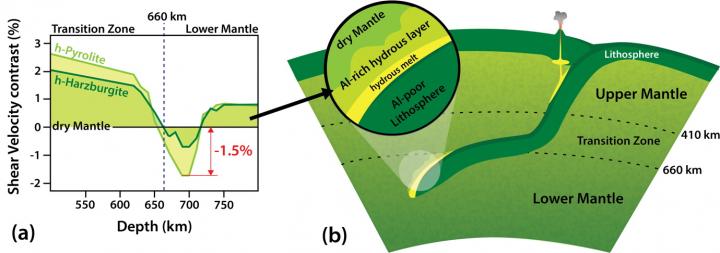
Credit: Ehime University
Since the discovery of a water-bearing ringwoodite specimen trapped in a superdeep diamond from Brazil by Pearson et al., in 2014 (published in Nature), there is a regained interest for finding and characterizing the potential carrier and host minerals of water in the deep Earth’s interior. Among the candidate minerals, Dense Hydrous Magnesium Silicates (DHMSs) are considered as primary water carriers from the shallow lithosphere to the deep mantle transition zone (MTZ; 410-660 km in depth), but because of their relative instability against pressure (P) and temperature (T), DHMSs were generally associated with the presence of water up to the middle-part of the MTZ.
An experimental study published also in 2014, in the journal Nature Geoscience however showed that when aluminum incorporates DHMSs, their stability against P and T is drastically improved, allowing those minerals to transport and host water up to depths of 1200 km in the lower mantle (Pamato et al., 2014). Their experiments indeed showed that the aluminum-bearing DHMS mineral called Al-phase D is likely to form at the uppermost lower mantle P and T conditions, from the recrystallization of hydrous melt at the boundary of the mantle and the subducted slab. Although this reaction was justified by laboratory experiments, there were no direct measurement of the sound velocities of Al-phase D and therefore it was difficult to associate the presence of Al-rich hydrated rocks to the seismic observations at the bottom of the MTZ and in the uppermost lower mantle.
The researchers at Ehime successfully measured the longitudinal (VP) and shear (VS) velocities, as well as the density of Al-phase D, up to 22 GPa and 1300 K by mean of synchrotron X-ray techniques combined with ultrasonic measurements in situ at high P and and T, in the multi-anvil apparatus located at the beamline BL04B1 in SPring-8 (Hyogo, Japan). The results of their experiments provided a clear understanding of the sound velocities of Al-phase D under a wide P and T range, allowing for modelling the seismic velocities of hydrous rocks in the inner and outer parts of the subducted slab (Image 1). From these models they showed that the presence of an Al-rich hydrous layer including Al-phase D, in the uppermost lower mantle, would be associated with negative VS perturbations (-1.5%) while the corresponding VP variations (-0.5%) would remain below the detection limit of seismological techniques. These new data should greatly contribute to tracing the existence and recycling of the former subducted lithospheric crust and eventually the presence of water in the Earth’s lower mantle.
###
Media Contact
Public Relations Division
[email protected]
Related Journal Article
http://dx.




